Vivo X80 Pro 5G Review – Pros and cons, Verdict | 91Mobiles
Back in the day, the flagship smartphone segment was dominated by the Apple-Samsung duopoly. However, over the years, a number of brands have climbed up the ranks and built a strong case for their premium offerings too. So much so, buyers eyeing a top of the line Android phone in 2022 aren’t just spoilt for choices – they’re undoubtedly overwhelmed with the barrage of flagship launches. After all, between the OnePlus 10 Pro (review), the Xiaomi 12 Pro (review), the Realme GT 2 Pro (review), the Moto Edge 30 Pro and Samsung’s bevvy of Galaxy S22 range of phones, the market is flush with enticing, do-it-all, Android phones.

And, to make matters even more interesting (read – perplexing), Vivo has taken the wraps off of its 2022 flagship too. Dubbed the Vivo X80 Pro, the device offers everything under the sun to the end-users and comes toting a class-leading display, superbly fast wired and wireless charging speeds, and a proprietary gimbal camera system, among other things. Unsurprisingly, Vivo expects buyers to shell out a whopping Rs 79,999 for the phone which begs the question – is the company’s latest smartphone worth its expensive price tag? Well, read on to find out.
Verdict
The Vivo X80 Pro is an expensive proposition but the device will undoubtedly elevate your end-user experience. The handset offers a capable chipset and an excellent camera array that is bound to appease both, photographers as well as videographers. That said, the device’s software interface leaves a little to be desired.
Design and I/O
One look at Vivo’s product portfolio and you’ll notice that the company’s smartphones put design above everything else. The Vivo V23 Pro (review), for instance, donned a colour changing AG Fluorite glass back panel which would completely revamp the phone’s aesthetics under the sun. Unsurprisingly, the company’s latest contender is dressed to the nines as well and the smartphone sets the stage for a luxurious experience from the minute you unbox the device.

To wit, the Vivo X80 Pro comes packaged in a gorgeous box that is replete with accessories, including but not limited to a pair of Type-C wired earphones, a stylish case and a fast-charging brick. The smartphone in question offers a sturdy, flex-free frame too, that feels unmistakably luxurious to the touch. The same can be accredited to the X80 Pro’s glass-metal sandwich chassis which, truth be told, has become somewhat commonplace for high-end Android phones.
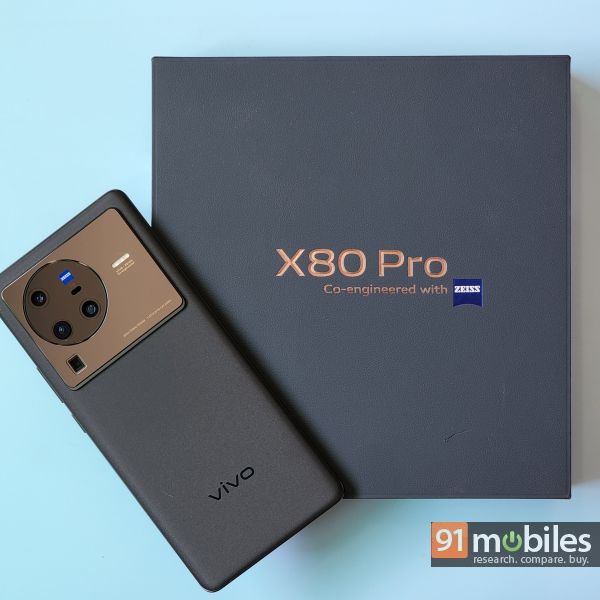
Even so, the X80 Pro’s design is as unique as it gets and the smartphone doesn’t bear any resemblance to competing devices. You can chalk up the phone’s distinctive appearance to its ginormous, glossy camera array which, doesn’t just complement the back’s matte finish admirably, but it also captivates the audience, should it meet their gaze. Now, in all fairness, the smartphone’s misaligned camera sensors did trigger my peers’ OCD. However, they echoed my sentiments pertaining to the smartphone’s overall build quality and premium in-hand feel too.
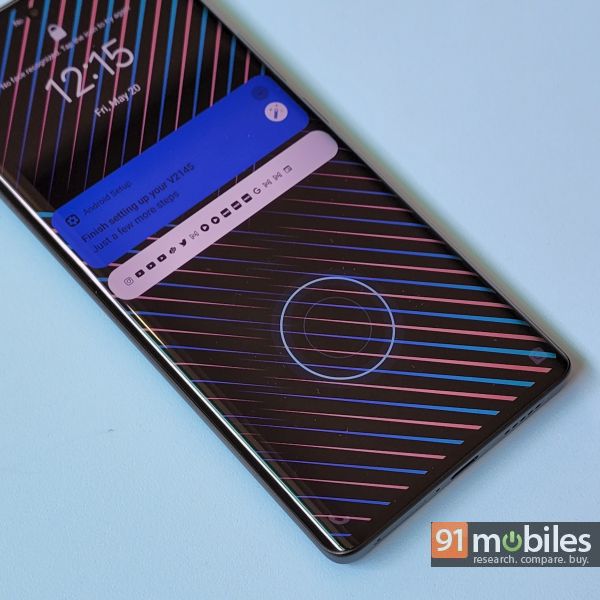
If anything, I wish the device was available in more peppy colours. While the cosmic black variant sent to me for review exudes elegance and is tailor-made for an office setting, I was more enamoured by the X80’s urban-blue hue. On the bright side, the X80 Pro features a fantastic in-display ultrasonic fingerprint scanner which, much like the one on the iQOO 9 Pro (review), can register and authenticate your fingerprints in the blink of an eye. The smartphone’s facial recognition tech worked just as well, and you can even enable a screen-flash feature to unlock the phone when it’s dark outside.
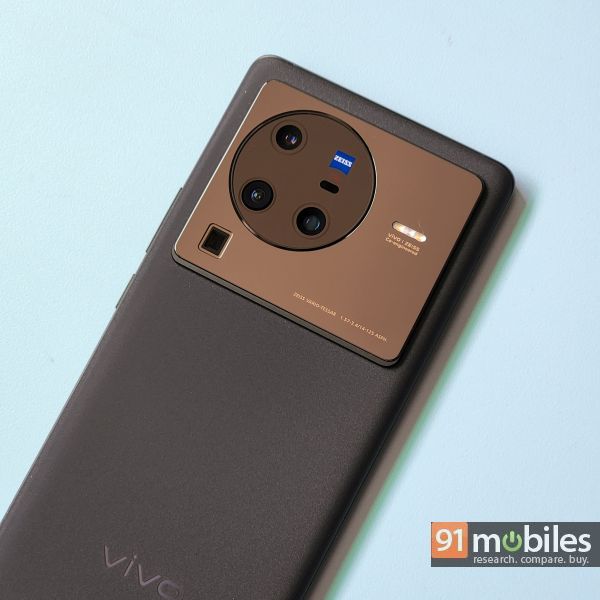
More notably, unlike most competing flagships, the Vivo X80 Pro ships with IP68 certification. Furthermore, the device’s display comes layered with Schott Xensation UP, which further fortifies the X80 Pro against accidental dings and scuffs. As for the rest of the I/O, the handset features a USB 3.1 Type-C connector at the bottom, along with a clicky volume rocker and power button positioned on its right-hand spine. The device touts an X-axis linear motor too which paves the way for a joyous typing experience as well.
Display and Audio
The Vivo X80 Pro ships with a 6.78-inch, E5 curved AMOLED panel. The panel is backed by LTPO 3.0 tech and correspondingly, can smartly variate its refresh rate between 1Hz to 120Hz. That said, the X80 Pro gives buyers the option to lock the display’s refresh rate at 120Hz as well. Moreover, the screen is fairly pixel-dense and the panel offers a 2K (3,200 x 1,440 pixels) resolution too. Needless to say, the X80 Pro’s display is among the best in the biz and the panel exhibits tasteful, punchy colours and offers wide viewing angles. What’s more, the screen gets adequately bright at 1,500 nits too, and the display even picks up on a user’s inputs instantaneously, owing to its snappy 300Hz touch sampling rate.
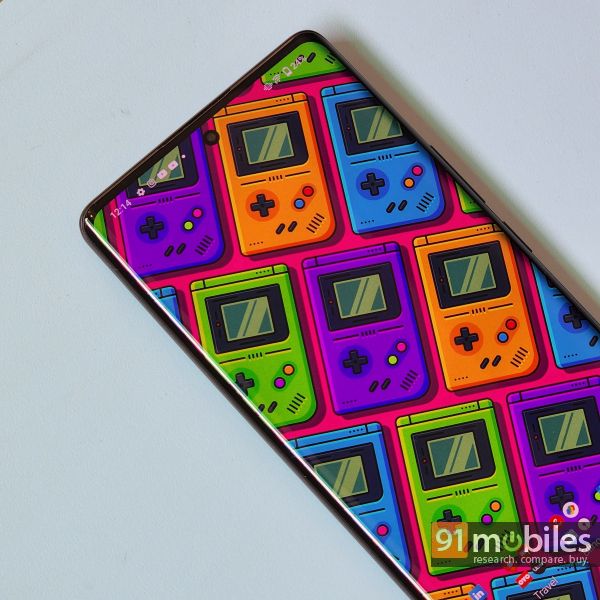
I should also add that the smartphone can relay both, HD as well as HDR media from OTT services like Netflix. The icing on the cake is that the panel is bordered by extremely sleek bezels too, which, when coupled with the phone’s fantastic stereo speaker setup, facilitates immersive gaming and movie-watching experience. Truth be told, it’s hard to find a fault with the Vivo X80 Pro’s screen. While I did notice slight discolouration alongside the curved edges of the phone, the X80 Pro’s panel gets a lot right. In fact, the screen is of the 10-bit variety too, so you will be able to experience a wider gamut of colours with the phone. The device also offers a dedicated dark mode, along with an always-on display feature which can notify users of incoming notifications, as well as the time without unlocking the phone or turning on the display.
Performance, Software and Battery Life
No surprises here, the Vivo X80 Pro makes use of the Snapdragon 8 Gen 1 platform for its processing needs. The SoC has been paired with 12GB of quad-channel, LPDDR5 memory and 256GB of UFS 3.1 storage. Now, we’ve already seen a handful of flagships launch with the aforementioned specs and suffice it to say, new-age Androids offer oodles of horsepower under the hood. That said, a good chunk of top-dollar phones are plagued by heating issues too. After all, the faster the SoC, the more heat it will likely generate when deploying its cores and GPU to complete a demanding task. Case in point, the Xiaomi 12 Pro, which got extremely warm to the touch when I was running benchmarks and games on the device.
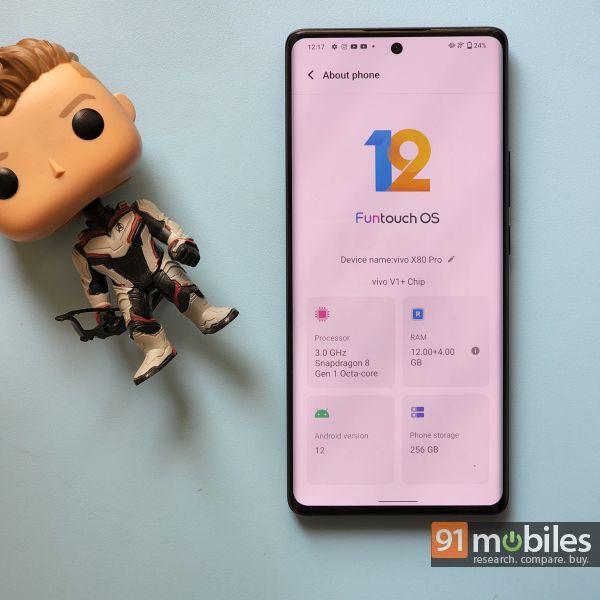
Now, while the Vivo X80 Pro gets noticeably warm too, the device doesn’t heat up as much as some competing devices. Furthermore, the handset’s stability and throttling scores in 3D Mark’s Extreme stress test as well as the CPU throttling test were to my liking as well. On that note, the device yielded 75.8 percent stability in the former and throttled to just 72 percent of its peak performance in the latter. I even played taxing games on the phone for extended periods, the likes of which include BGMI, Apex Legends Mobile and Nimian Legends: BrightRidge. And, despite maxing out the graphics and FPS settings on the aforementioned titles, the smartphone didn’t show any major signs of struggle and would only drop frames every once in a while. Rest assured, buyers in the market for a high-performance flagship will find plenty to like about the X80 Pro.
Unfortunately, that’s more than I can say about the smartphone’s FunTouch OS interface that comes layered on top of Android 12. Now, while I am glad that the utility doesn’t riddle a user’s notification tray with unnecessary ads and promotional offers, the device ships with a ton of bloatware. That’s quite disappointing, seeing how the phone costs a good chunk of money. What’s more, the X80 Pro’s FunTouch OS doesn’t support icon packs either. On the flip side, unlike Xiaomi’s offerings, you can use navigational gestures when using third-party launchers like Nova, Nothing Launcher, etc on the phone.
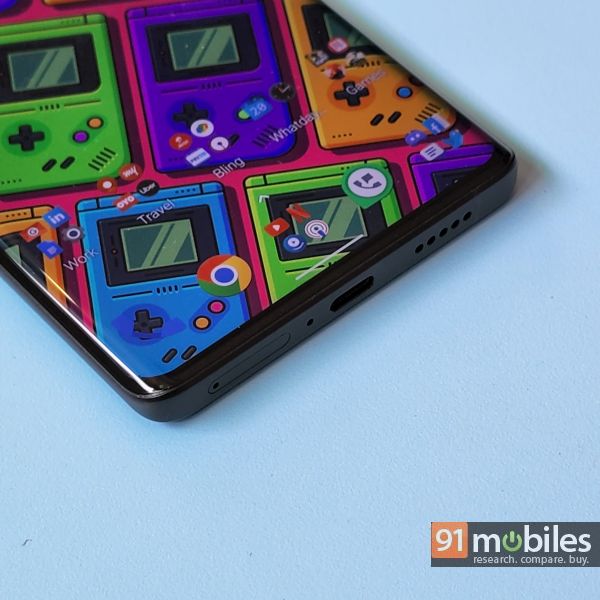
The Vivo X80 Pro is fuelled by a 4,700mAh cell which, with the display set to 2K resolution and the refresh rate locked at 120Hz, offered around five hours of screen on time. My usage comprised browsing on various social media platforms, playing casual games like Clash Royale on the phone and watching videos on YouTube and Netflix. Now, your mileage could vary, especially if you tweak the display settings. Regardless, the phone charges rapidly at 80W and I was able to refuel the battery in a little under 45 minutes with the bundled charging brick. The phone is compliant with wireless charging (50W) and you can even use the handset’s reverse wireless charging feature to top up say, your TWS earphones.
Cameras
Vivo’s X-series of devices are chockablock with unique photography and videography features and the X80 Pro is no exception to the rule. But, before I get into that, let’s take a closer look at the smartphone’s camera specs. As prefaced previously, the Vivo X80 Pro features a quad-camera setup at the back, comprising a 50MP Samsung GNV main sensor, a 12MP 2x portrait lens, an 8MP 5x periscope lens and a 48MP Sony IMX598 ultrawide sensor. For selfies, the device gets a 32MP snapper up front.
Now, I’ve already penned down my thoughts on the smartphone’s cameras in my detailed comparison where I pit the Vivo X80 Pro against the OnePlus 10 Pro. You can refer to the article for more insights, however, I’ll sum up my findings here to get you up to speed –
- The Vivo X80 Pro’s main sensor has a lot going for it and the camera can snap delightful images during the day. Now, from the get-go, the handset clicks overtly saturated images, however, you can enable the phone’s Zeiss mode to better the output tenfold. To wit, colours appear superbly accurate with the feature turned on. In fact, the utility comes particularly in handy when snapping photos of human subjects and closeups of flowers with vibrant petals. That said, the smartphone’s main sensor renders the elements towards the periphery of the frame a tad soft. Other than that, however, the output from the X80 Pro’s main sensor will not leave you wanting for more.
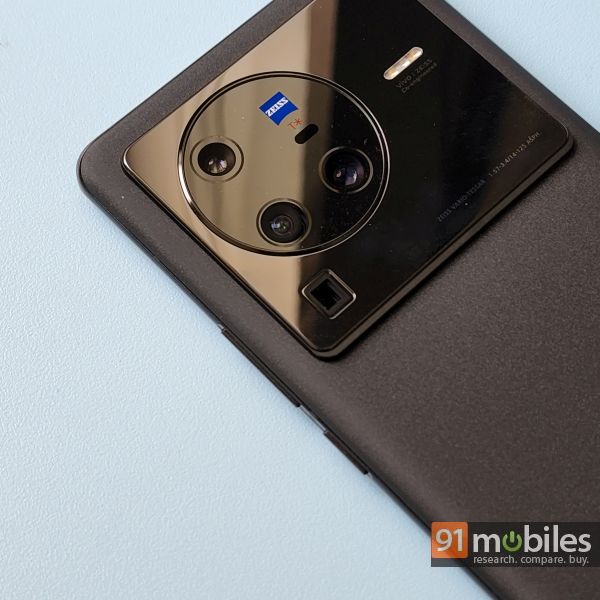
- For instance, in the slider attached above, you can tell that the petals of the flower look more realistic in the photo with the Zeiss mode enabled. The pinkish tinge doesn’t overshadow the white base and the colour of the leaves in the background has been reciprocated to a tee too.
- The sensor is equally adept at snapping images of human subjects too. For one, it outturns a colour-accurate photo and the unit even creates a convincing bokeh effect around the subject. The same goes for the X80 Pro’s 5x periscope lens too. While the sensor can’t quite match the 5x output from the Galaxy S22 Ultra (review), the images I snapped with the unit offered adequate sharpness and were exposed properly too. That said, the quality of the photos takes a huge hit as you climb up the zoom ladder.
- The ultrawide sensor could do with some tweaks, though. While the photos are replete with details and the output is considerably more information-dense than the snaps from say, the OnePlus 10 Pro, the images exhibit blown-out highlights. On the flip side, the smartphone clicks superbly detailed images after the sun has set. The photos offer excellent sharpness and the sensor keeps instances of ghosting and lens flaring under the lid too, which can be accredited, at least in parts, to the phone’s Zeiss T* coating.
- It also helps that the Vivo X80 Pro is loaded to the brim with a ton of video-centric features. For one, the handset’s gimbal-assisted camera system can record extremely stabalised clips and you’ll rarely find any jarring transitions in the videos snapped by the device. The experience is further elevated with features like horizon level stablisation and Zeiss cinematic bokeh mode. To wit, with horizon level stablisation enabled, the smartphone can – for the lack of a better word – freeze the videographer’s perspective and offer a 360-degree stabilised video regardless of how you’re gripping and moving the phone. And, if you want the subject to stand out that much more, you can utilise the Zeiss cinematic bokeh mode, which blurs the background eloquently. Lest I forget, much like most other flagships, the Vivo X80 Pro can record videos in up to 8K resolution as well, which is great.
Final Verdict
The Vivo X80 Pro retails for Rs 79,999 and for the price, checks most, if not all of the right boxes. For starters, the device offers a premium design that has been paired with a stunning screen. The handset performs like a champ too, and offers a capable camera array that is bound to appease budding photographers and videographers. It also helps that the device supports wireless charging, and touts a weatherproof ingress protection rating too. Don’t get me wrong, the phone isn’t perfect and I firmly believe that the device would benefit immensely from a bloat-free custom skin.

Furthermore, you could even make a case for competing Android phones from Xiaomi and OnePlus’ stables, which, despite employing similar specs, retail for much less. Be that as it may, it’s hard to turn a blind eye to the X80 Pro’s camera capabilities. And, unlike the competition, the handset is IP68 certified too. Correspondingly, buyers in the market for a premium Android phone can consider picking up the Vivo X80 Pro.
Editor’s rating: 4 / 5
Pros:
- Stylish design
- Stunning display
- Extremely snappy biometrics
- Good performer
- Great cameras
- IP68 certified
Cons:
- UI riddled with bloatware
- Expensive
For all the latest Technology News Click Here
For the latest news and updates, follow us on Google News.
